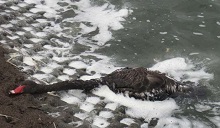Cases of avian botulism found in Victoria
Yonatan Segal
Principal Veterinary Officer, Poultry and Zoonoses
In late February 2017, a high mortality rate of Australian Shelducks at Lake Buloke Donald near Swan Hill in North Victoria was reported. Approximately 500 dead birds were observed on the water's edge over a three kilometre stretch of the eastern side of the lake. The dead birds were in good muscular cover and had internal fat. Some sick birds exhibited signs of leg and wing paralysis.
 Internal organs from dead birds were removed and sent to AgriBio Laboratory for analysis. Samples of intestinal swabs were tested by PCR and were found to be negative to avian influenza (AI) and Newcastle disease (ND). The intestinal content was sent to the Department of Agriculture and Food laboratory of Western Australia (DAFWA) for the identification of botulinum toxins. The samples were tested by ELISA and were found to be negative to botulinum toxins of type C and D.
Internal organs from dead birds were removed and sent to AgriBio Laboratory for analysis. Samples of intestinal swabs were tested by PCR and were found to be negative to avian influenza (AI) and Newcastle disease (ND). The intestinal content was sent to the Department of Agriculture and Food laboratory of Western Australia (DAFWA) for the identification of botulinum toxins. The samples were tested by ELISA and were found to be negative to botulinum toxins of type C and D.
Avian botulism was suspected in the affected birds at the lake as clinical signs that are typical of the disease, namely leg and wing paralysis, were observed in birds and alternative disease conditions such as AI and ND were ruled out.
It is important to remember that, currently, not all seven types of botulinum toxins can be diagnosed by the laboratory.
Avian botulism is a disease caused by several different strains of the bacterium Clostridium botulinum, which produces a toxin that acts on the neuromuscular system of animals and humans. The disease is characterised by paralysis leading to progressive muscle weakness and eventually respiratory arrest if left untreated. Several distinct strains have been identified and types C and E, in particular, are known to affect birds and fish. While type C has not been shown to cause illness in humans, type E does.
Avian botulism has been linked to mortalities in marshes and wetlands. Dormant spores of this bacterium are naturally abundant in soils and freshwater body sediments, but are not always in the vegetative state, capable of producing the toxin. These spores can also be found in the intestinal tracts of live, healthy animals. The spores are resistant to extreme temperatures and desiccation and are therefore capable of surviving in the ecosystem for long periods of time.
Animals, especially wild birds, can contract avian botulism when they prey on other animals that harbour the toxin (such as sick or dead fish and birds) or consume infected maggots derived from dead animals. Effects of toxin poisoning include paralysis, which often leads to death. Death can also result from secondary water deprivation, electrolyte imbalance, respiratory failure, or predation due to paralysis. Quick removal of dead birds (potential vectors) is important in dealing with an avian botulism outbreak.
Outbreaks generally occur in Victoria from November through to April. Many birds may die during a single outbreak. No lesions are specifically associated with this disease but some visual signs of avian botulism infection are typically evident.
Affected birds often have trouble holding up their heads, a condition known as 'limber neck' which can lead to drowning. They may also exhibit an inability to fly or walk or may appear emaciated if they have been poisoned over an extended period of time. Birds that have lost the power of flight and use of their legs often attempt escape by propelling themselves across the water. Another common sign in intoxicated birds is paralysis of the inner eyelid. Dead birds often appear in good body condition because avian botulism toxin generally kills rapidly after intoxication.